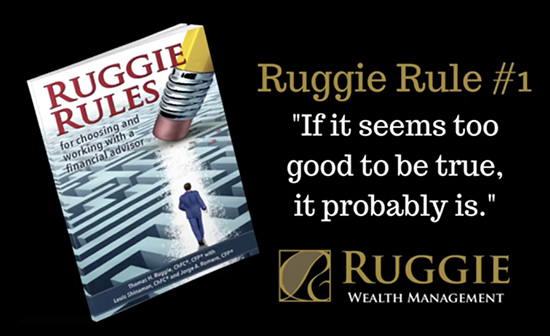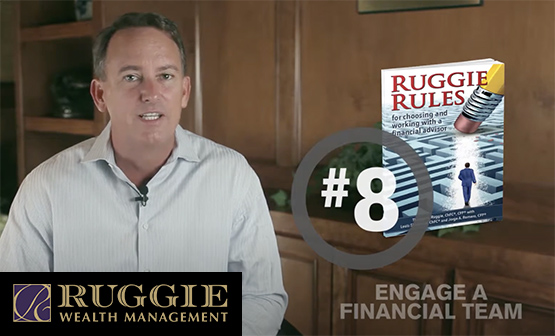New Year 2016/Fourth Quarter Market Review 2015
Welcome to our New Year 2016/Fourth Quarter Market Review for 2015, in which Tom shares his insights on the current markets, last quarter’s markets and looks at 2015 in the rearview mirror. He also addresses Ruggie Wealth’s investment strategies moving forward. We know you may have questions, and as always we’re here to answer them. Transcript: Welcome to our end of the year 2015 commentary. While I normally cover the past quarter’s activities, I would be remiss if I did not discuss the first three weeks of January.The start of this year has certainly been ugly. As I am sure you are all well-aware, we are off to quite a negative start to 2016. In fact, this year’s start is the worst start in the history of the market to a new year.So what is going on? Where are we going? What are we doing and what should you do?The market continues to be weighted down by two factors: China and Oil with a small dab of uncertainty in Fed monetary policy.I’m not going to talk too much here about these factors as we have been commenting on them every week within our weekly commentary. However, it is our belief:-Oil pricing will stabilize over the next month or so bringing stabilization to the market along with it. While we are well aware of the downside created by having too much oil supply (who would have thought this years ago?), what the market has yet to acknowledge is the equal and opposite upside this provides to many companies and certainly to us as consumers. There is a notion called consumer surplus, which means due to certain circumstances, there is a surplus created in cash flow for consumer almost like a tax savings. Cheaper oil is providing this to us as is exponential technology.-We also believe China will stabilize though this may take a bit longer as they will need to tweak their fiscal and monetary policy. Again, we do not see this as a long-term detriment to investing in the broad market.Finally, we believe domestic economic indicators will continue to be positive but probably not positive enough to temper short-term fears until we see some stabilization in the problem areas. In our opinion, the worst we would expect to see is a 20% downside to the market, which is already down about 10%. Frankly, I would be surprised if it hit this level but the momentum is certainly negative right now. Even if the downside for stocks may be 20%, we see more potential upside than downside over the course of 2016. Twenty percent is the definition of a bear market. Bear markets are usually accompanied by recessions, which few experts believe a recession is likely for the US in 2016. As mentioned last quarter, pullbacks (10%) and bear markets (20%) are a very natural part of market cycles. So what are we doing? By and large, we have left all of our portfolios intact. We made a slight adjustment to take some risk off the table in our more moderately managed portfolio and made a tactical adjustment in our more aggressive portfolio. If we believe things have much more downside, it is possible we would continue to scale down on a few positions while, at the same time, we are looking for an opportunity to get slightly more aggressive within our Dynamic Growth portfolio. You may recall; we took 10% out of equities in this portfolio last April, at a market high and we would like to put this money back to work during this downturn. So what should you do? Well here comes the pep talk. You should do nothing. You should not be watching the markets on TV, checking the balances on-line and some of you should not even open your statements. You will drive yourself crazy doing this. You pay us to be driven crazy and believe me; this is where we earn our pay. Having been through dozens of downturns in my 25-year career, I believe we know the solutions though it certainly does not make things any easier. I do want you to feel free to call our office if you have questions or would like to discuss your personal situation. However, I’m confident we have put a proper strategic plan in place for you and I’m also confident things will ultimately work out as expected.I will focus minor attention to Q4 of 2015 as I’m sure most of you are much more interested in today and tomorrow as compared to last quarter.As ugly as 2016 has been thus far there was no great news for 2015 either. A couple of articles from a weekly Investment newspaper I receive are titled: World’s richest people lost $19B in 2015 while another title is: The year that stocks, bonds, and cash failed to thrive and finally a third from the same paper: Outlook 2016: Optimism Prevails. The year started out positive but around April it turned negative, and although we had a bit of a turnaround in Q4, we were never able to get back to the highs we enjoyed early in 2015.For the quarter, capital markets rebounded as US equity was up 6.1% putting the Russell 3000 index just above break-even for the year at a positive .5%. Overseas international markets underperformed the US posting a 4.7% return for the quarter but a negative .4% for the year. The fourth quarter marked the Fed’s first rate hike since 2006, significant because monetary policy finally turned to one of tightening. The hike was evidence of the Fed’s confidence about the status of and prospects for the U.S economy. It will be interesting to see where they go from here considering our start to the year.US equity styles were all positive for the quarter but mixed for the year with the US large, mid and small value holdings all posting losses of 1.4%, 3.8% and 7.1% for the year. From a sector standpoint, it was a mixed bag as well with Consumer Discretionary leading the way up 10.1% while Energy was down 21.1% and Materials were down 8.4%.As already mentioned, international struggled as well with Emerging Markets posting a loss of 14.6% for the year.Fixed income was relatively flat for the year with the aggregate bond market up .5%, and high-yield bonds were the worst performing at a loss of 4.5%.I won’t focus in on this Kaleidoscope put together by one of the management companies we utilize, but it provides a quick rundown of the major asset categories and for 2015 it reads like this:Russell 1000 Growth up 5.67%Balanced Index up .59%Aggregate Bond up .55%International Index down .39%Russell 2000 Growth down 1.39%Russell 1000 Value down 3.83%Russell 2000 Value down 7.47%Again, in summary, a disappointing 2015 across the board.In closing, given the pullback we’ve already experienced in 2016, I wanted to provide you with an interesting statistic. Over the past 36 years, the average intra-year decline was 14.2% per year. In other words, if we were to look at the worst period over every year for the last 36 years and average it out, there was an average drop in the market during the year of 14.2%. Yet the market finished positive 75% of the time or 27 out of the last 36 years.I again invite you to contact us with any questions, thoughts or concerns. And thank you for your continued trust and confidence.
Posted by Ruggie Wealth Management on Thursday, January 21, 2016
Welcome to our New Year 2016/Fourth Quarter Market Review for 2015, in which Tom shares his insights on the current markets, last quarter’s markets and looks at 2015 in the rearview mirror. He also addresses Ruggie Wealth’s investment strategies moving forward. We know you may have questions, and as always we’re here to answer them.
Transcript: Welcome to our end of the year 2015 commentary.
While I normally cover the past quarter’s activities, I would be remiss if I did not discuss the first three weeks of January.
The start of this year has certainly been ugly. As I am sure you are all well-aware, we are off to quite a negative start to 2016. In fact, this year’s start is the worst start in the history of the market to a new year.
So what is going on? Where are we going? What are we doing and what should you do?
The market continues to be weighted down by two factors: China and Oil with a small dab of uncertainty in Fed monetary policy.
I’m not going to talk too much here about these factors as we have been commenting on them every week within our weekly commentary. However, it is our belief:
-Oil pricing will stabilize over the next month or so bringing stabilization to the market along with it. While we are well aware of the downside created by having too much oil supply (who would have thought this years ago?), what the market has yet to acknowledge is the equal and opposite upside this provides to many companies and certainly to us as consumers. There is a notion called consumer surplus, which means due to certain circumstances, there is a surplus created in cash flow for consumer almost like a tax savings.
Cheaper oil is providing this to us as is exponential technology.
-We also believe China will stabilize though this may take a bit longer as they will need to tweak their fiscal and monetary policy. Again, we do not see this as a long-term detriment to investing in the broad market.
Finally, we believe domestic economic indicators will continue to be positive but probably not positive enough to temper short-term fears until we see some stabilization in the problem areas.
In our opinion, the worst we would expect to see is a 20% downside to the market, which is already down about 10%. Frankly, I would be surprised if it hit this level but the momentum is certainly negative right now. Even if the downside for stocks may be 20%, we see more potential upside than downside over the course of 2016. Twenty percent is the definition of a bear market. Bear markets are usually accompanied by recessions, which few experts believe a recession is likely for the US in 2016. As mentioned last quarter, pullbacks (10%) and bear markets (20%) are a very natural part of market cycles.
So what are we doing? By and large, we have left all of our portfolios intact. We made a slight adjustment to take some risk off the table in our more moderately managed portfolio and made a tactical adjustment in our more aggressive portfolio. If we believe things have much more downside, it is possible we would continue to scale down on a few positions while, at the same time, we are looking for an opportunity to get slightly more aggressive within our Dynamic Growth portfolio. You may recall; we took 10% out of equities in this portfolio last April, at a market high and we would like to put this money back to work during this downturn.
So what should you do? Well here comes the pep talk. You should do nothing. You should not be watching the markets on TV, checking the balances on-line and some of you should not even open your statements. You will drive yourself crazy doing this. You pay us to be driven crazy and believe me; this is where we earn our pay. Having been through dozens of downturns in my 25-year career, I believe we know the solutions though it certainly does not make things any easier. I do want you to feel free to call our office if you have questions or would like to discuss your personal situation. However, I’m confident we have put a proper strategic plan in place for you and I’m also confident things will ultimately work out as expected.
I will focus minor attention to Q4 of 2015 as I’m sure most of you are much more interested in today and tomorrow as compared to last quarter.
As ugly as 2016 has been thus far there was no great news for 2015 either. A couple of articles from a weekly Investment newspaper I receive are titled: World’s richest people lost $19B in 2015 while another title is: The year that stocks, bonds, and cash failed to thrive and finally a third from the same paper: Outlook 2016: Optimism Prevails.
The year started out positive but around April it turned negative, and although we had a bit of a turnaround in Q4, we were never able to get back to the highs we enjoyed early in 2015.
For the quarter, capital markets rebounded as US equity was up 6.1% putting the Russell 3000 index just above break-even for the year at a positive .5%. Overseas international markets underperformed the US posting a 4.7% return for the quarter but a negative .4% for the year.
The fourth quarter marked the Fed’s first rate hike since 2006, significant because monetary policy finally turned to one of tightening. The hike was evidence of the Fed’s confidence about the status of and prospects for the U.S economy. It will be interesting to see where they go from here considering our start to the year.
US equity styles were all positive for the quarter but mixed for the year with the US large, mid and small value holdings all posting losses of 1.4%, 3.8% and 7.1% for the year. From a sector standpoint, it was a mixed bag as well with Consumer Discretionary leading the way up 10.1% while Energy was down 21.1% and Materials were down 8.4%.
As already mentioned, international struggled as well with Emerging Markets posting a loss of 14.6% for the year.
Fixed income was relatively flat for the year with the aggregate bond market up .5%, and high-yield bonds were the worst performing at a loss of 4.5%.
I won’t focus in on this Kaleidoscope put together by one of the management companies we utilize, but it
provides a quick rundown of the major asset categories and for 2015 it reads like this:
Russell 1000 Growth up 5.67%
Balanced Index up .59%
Aggregate Bond up .55%
International Index down .39%
Russell 2000 Growth down 1.39%
Russell 1000 Value down 3.83%
Russell 2000 Value down 7.47%
Again, in summary, a disappointing 2015 across the board.
In closing, given the pullback we’ve already experienced in 2016, I wanted to provide you with an interesting statistic. Over the past 36 years, the average intra-year decline was 14.2% per year. In other words, if we were to look at the worst period over every year for the last 36 years and average it out, there was an average drop in the market during the year of 14.2%. Yet the market finished positive 75% of the time or 27 out of the last 36 years.
I again invite you to contact us with any questions, thoughts or concerns. And thank you for your continued trust and confidence.
 Did you know that the fastest-growing metropolitan area in the United States in 2014 and 2015 was not an oil town like Houston or Dallas, nor was it a coastal resort town like Myrtle Beach?
Did you know that the fastest-growing metropolitan area in the United States in 2014 and 2015 was not an oil town like Houston or Dallas, nor was it a coastal resort town like Myrtle Beach?Excerpted from Tom Ruggie’s newest book, Ruggie Rules. To learn more and pick up a copy of the book schedule a free consultation today by calling 352.343.2700. Our advisory team looks forward to meeting with you.



